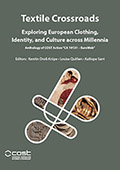Center, Textile Research

Textile Crossroads: Exploring European Clothing, Identity, and Culture across Millennia
Date of this Version
2024
Document Type
Article
Citation
In Textile Crossroads: Exploring European Clothing, Identity, and Culture across Millennia. Anthology of COST Action “CA 19131 – EuroWeb”. Kerstin Droß-Krüpe, Louise Quillien, & Kalliope Sarri, Editors. Zea Books, Lincoln, Nebraska, 2024. DOI: 10.32873/unl.dc.zea.1815
Abstract
The demographics of the Roman world suggest that it was a world full of children. Demographers argue that in order simply to maintain population levels in a period where life expectancy was very short by modern standards, and infant mortality high, a woman should, on average, have six children, on the assumption that not all would live to adulthood. Despite much research in the last fifty years, children still remain partly invisible in the Roman world. This is primarily because they leave little evidence produced by themselves and are seen through the prism of adult eyes. Inevitably, given the nature of the evidence, we know more about the children of the upper classes than the lower, and more about boys than girls.
Looking at the clothing of children presents particular difficulties precisely because there were very few garments that were specifically made for them. A comment by a Roman jurist on the nature of clothing in testamentary bequests lists first the clothing for the paterfamilias (togas, tunics, cloaks), then defines children’s clothing as: “clothes used only for this purpose, such as togae praetextae, coats, chlamydes and cloaks which we provide for our sons” (Digest 34.2.23.2). The list for sons essentially replicated the list of their father’s garments, and this idea of the child dressed in standard adult garments sized down for them is evidenced in much of the surviving iconography. The Roman wardrobe reflected that of most pre-industrial societies, in that, for most people, possessing more than one change of clothes would be a luxury. Everyday dress consisted of a tunic, which could be covered by a cloak or mantle; this outfit was worn by everyone, wealthy or poor, free or unfree, adult or child. Ancient authors were not particularly interested in their children’s clothing practices. The one exception to this would be the laying aside of the toga praetexta (the toga of childhood) and the assumption of the toga virilis (toga of manhood) as part of the transition to adulthood for male Roman citizens. Artistic representations from the private sphere or from funerary contexts are more rewarding for examining children’s clothing. Ordinary children and images of childhood are not frequent motifs in Roman public art. It is more useful to turn to private memorials, where clothed children of different ages are depicted in a range of contexts. A child could be a symbol of status; a freeborn son, in particular, would be a prestigious addition to a family. The higher social worth of boys compared to girls had an impact on their upbringing, education, and wider life experience. Another sign of the gendered view of children is that in artistic representations, boys are more commonly depicted than girls. From the first century BC, when the habit of erecting memorials became more socially diffused, children were more often included in the visual vocabulary. At first, they are normally seen included in family groups, but by the first century AD, children became subjects in their own right: on reliefs, funerary altars, and sarcophagi. In spite of memorials being related to a deceased person or persons, children were depicted as alive and healthy, and such images constitute an important source for how Roman children of various ages and social classes would have been dressed.
Included in
Ancient History, Greek and Roman through Late Antiquity Commons, Archaeological Anthropology Commons, Classical Archaeology and Art History Commons, Classical Literature and Philology Commons, Eastern European Studies Commons, European History Commons, European Languages and Societies Commons, Fiber, Textile, and Weaving Arts Commons, History of Science, Technology, and Medicine Commons, Human Geography Commons, Museum Studies Commons, Place and Environment Commons, Social and Cultural Anthropology Commons, Women's Studies Commons


Comments
Copyright © 2024 by the authors.